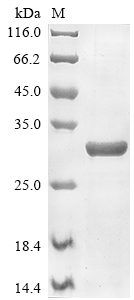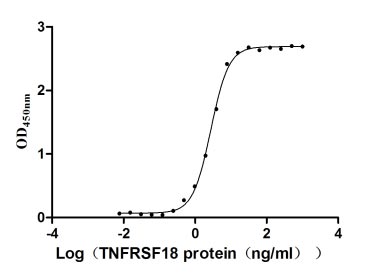Recombinant Mouse Transcriptional enhancer factor TEF-3 (Tead4), partial
In Stock-
货号:CSB-EP737076MO2b1
-
规格:¥2328
-
图片:
-
其他:
产品详情
-
纯度:Greater than 85% as determined by SDS-PAGE.
-
基因名:
-
Uniprot No.:
-
别名:Tead4; Tcf13r1; Tef3; Tefr1; Transcriptional enhancer factor TEF-3; ETF-related factor 2; ETFR-2; TEA domain family member 4; TEAD-4; TEF-1-related factor 1; TEF-1-related factor FR-19; RTEF-1
-
种属:Mus musculus (Mouse)
-
蛋白长度:Partial
-
来源:E.coli
-
分子量:33.0 kDa
-
表达区域:210-427aa
-
氨基酸序列RSIASSKLWMLEFSAFLERQQDPDTYNKHLFVHISQSSPSYSDPYLETVDIRQIYDKFPEKKGGLKELFERGPSNAFFLVKFWADLNTNIDDEGSAFYGVSSQYESPENMIITCSTKVCSFGKQVVEKVETEYARYENGHYLYRIHRSPLCEYMINFIHKLKHLPEKYMMNSVLENFTILQVVTNRDTQETLLCIAYVFEVSASEHGAQHHIYRLVKE
Note: The complete sequence including tag sequence, target protein sequence and linker sequence could be provided upon request. -
蛋白标签:N-terminal 10xHis-tagged and C-terminal Myc-tagged
-
产品提供形式:Liquid or Lyophilized powder
Note: We will preferentially ship the format that we have in stock, however, if you have any special requirement for the format, please remark your requirement when placing the order, we will prepare according to your demand. -
缓冲液:If the delivery form is liquid, the default storage buffer is Tris/PBS-based buffer, 5%-50% glycerol. If the delivery form is lyophilized powder, the buffer before lyophilization is Tris/PBS-based buffer, 6% Trehalose.
-
复溶:We recommend that this vial be briefly centrifuged prior to opening to bring the contents to the bottom. Please reconstitute protein in deionized sterile water to a concentration of 0.1-1.0 mg/mL.We recommend to add 5-50% of glycerol (final concentration) and aliquot for long-term storage at -20°C/-80°C. Our default final concentration of glycerol is 50%. Customers could use it as reference.
-
储存条件:Store at -20°C/-80°C upon receipt, aliquoting is necessary for mutiple use. Avoid repeated freeze-thaw cycles.
-
保质期:The shelf life is related to many factors, storage state, buffer ingredients, storage temperature and the stability of the protein itself.
Generally, the shelf life of liquid form is 6 months at -20°C/-80°C. The shelf life of lyophilized form is 12 months at -20°C/-80°C. -
货期:3-7 business days
-
注意事项:Repeated freezing and thawing is not recommended. Store working aliquots at 4°C for up to one week.
-
Datasheet & COA:Please contact us to get it.
相关产品
靶点详情
-
功能:Transcription factor which plays a key role in the Hippo signaling pathway, a pathway involved in organ size control and tumor suppression by restricting proliferation and promoting apoptosis. The core of this pathway is composed of a kinase cascade wherein MST1/MST2, in complex with its regulatory protein SAV1, phosphorylates and activates LATS1/2 in complex with its regulatory protein MOB1, which in turn phosphorylates and inactivates YAP1 oncoprotein and WWTR1/TAZ. Acts by mediating gene expression of YAP1 and WWTR1/TAZ, thereby regulating cell proliferation, migration and epithelial mesenchymal transition (EMT) induction. Binds specifically and non-cooperatively to the Sph and GT-IIC 'enhansons' (5'-GTGGAATGT-3') and activates transcription. Binds to the M-CAT motif. Might play a role in the embryonic development of skeletal muscle.
-
基因功能参考文献:
- TEAD4 mediated the interaction between YAP1 and c-JUN. YAP1 and the YAP1-TEADs complex have roles in regulating osteoclastogenesis and related gene expression. PMID: 29432919
- Based on the similarity to a related family member, and in vitro transcription/translation product(s), the s propose that translation initiates from a non-AUG (AUA or AUU) start codon. PMID: 8920920
- AP-1- and TEAD4-associated cis-regulatory elements form hubs for multiple signalling-responsive transcription factors and define the cistrome that regulates vascular and hematopoietic development by extrinsic signals. PMID: 27802171
- Dual-luciferase reporter gene analysis showed that RTEF-1 is a direct target of mir-125a-5p, which regulates angiogenesis by repressing RTEF-1 expression and modulating eNOS and VEGF expression. PMID: 25059272
- TEAD4 establishes the energy homeostasis essential for blastocoel formation. PMID: 23903192
- These results show that RTEF-1-stimulated IGFBP-1 expression may be central to the mechanism by which RTEF-1 attenuates blood glucose levels. PMID: 22843786
- Vgll1 interacts with TEAD4 in a manner similar to the transcription coactivators, as well as oncogenes YAP and TAZ, despite having a varied primary sequence. Vgll1 has the potential to promote cancer progression. PMID: 22632831
- endothelial-specific RTEF-1 overexpressing mice had enhanced angiogenic sprouting and vascular structure remodeling, resulting in the formation of a denser and more highly interconnected superficial capillary plexus PMID: 22652601
- Data suggest that altered subcellular localization of TEAD4 in blastomeres dictates first mammalian cell fate specification. PMID: 22529382
- TEAD factors directly induce Myogenin, CDKN1A and Caveolin 3 expression to promote myoblast differentiation. PMID: 21701496
- Gata3 and Cdx2 can act in parallel pathways downstream of Tead4 to induce the expression of common and independent targets in the trophoblast lineage, whereas Oct4 is required for continued repression of trophoblast fate in the embryonic lineage PMID: 20081188
- Novel RTEF-1 transcripts are present within human ocular vascular endothelial cells and mouse neural retina during normal and retinopathy of prematurity development, and alternatively spliced products are produced under hyperoxic and hypoxic conditions PMID: 17652751
- RTEF-1 regulated smooth muscle alpha-actin transcription in myofibroblasts, but not in differentiated smooth muscle PMID: 17823374
- Tead4 is the earliest gene shown to be uniquely required for specification of the trophectoderm lineage PMID: 17913785
- Tead4 has a distinct role from Tead1 and Tead2 in trophectoderm specification of pre-implantation embryos; it is an early transcription factor required for specification and development of the trophectoderm lineage, which includes expression of Cdx2. PMID: 18083014
显示更多
收起更多
-
亚细胞定位:Nucleus.
-
组织特异性:Preferentially expressed in lung and in skeletal muscle.
-
数据库链接:
KEGG: mmu:21679
STRING: 10090.ENSMUSP00000006311
UniGene: Mm.14774
Most popular with customers
-
Recombinant Human Tumor necrosis factor receptor superfamily member 18 (TNFRSF18), partial (Active)
Express system: Mammalian cell
Species: Homo sapiens (Human)
-
Recombinant Mouse Cell adhesion molecule 1 (Cadm1), partial (Active)
Express system: Mammalian cell
Species: Mus musculus (Mouse)
-
Recombinant Human Interleukin-2 receptor subunit alpha (IL2RA), partial (Active)
Express system: Mammalian cell
Species: Homo sapiens (Human)
-
Recombinant Human CD70 antigen (CD70), partial (Active)
Express system: Mammalian cell
Species: Homo sapiens (Human)
-
Recombinant Macaca Gastric inhibitory polypeptide receptor(GIPR), partial (Active)
Express system: yeast
Species: Macaca fascicularis (Crab-eating macaque) (Cynomolgus monkey)
-
Recombinant Human C-C chemokine receptor type 5 (CCR5)-VLPs (Active)
Express system: Mammalian cell
Species: Homo sapiens (Human)



















